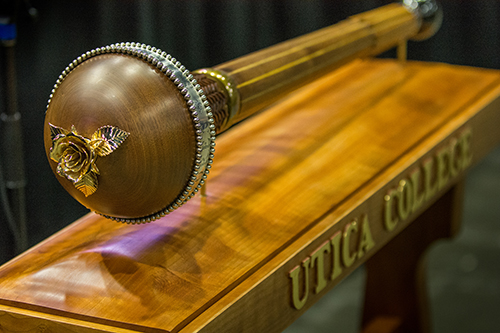PRESIDENTIAL INAUGURATION
Utica College Inauguration Traditions
ACADEMIC REGALIA

The academic procession is a pageant bright with the dress and ceremony inherited from the medieval universities of the 11th and 12th centuries. The caps, gowns, and hoods were worn to keep students and professors warm and distinguish clerical and academic groups from laity. Academic regalia is worn today by those who play an academic role at celebrations of scholarly significance.
The traditional costumes were used in few universities in America prior to the 1880s. With the growth in the late 19th century of institutions of higher learning, American universities in 1895 agreed on a definite system and set up a suitable code of academic dress for colleges and universities in the United States. In 1932 the American Council on Education presented a revised code, which, for the most part, governs the style of academic dress today.
THE MACE OF UTICA COLLEGE

The mace is a symbol of the unique mission of Utica College, which is to provide a college education that is accessible to all, liberal and humanizing, practical and purposeful.
- The basalt foot is a symbol of our commonality and shared predicament as children of the Earth, mother of all living things.
- Strength, endurance, and beauty are characteristics of the black walnut core. These characteristics are symbolic of the peoples who have come to share this culture. The inlays of woods from around the world are symbols of the interdependence of modern civilizations and the enrichment of the human life that results when we learn from one another.
- Peaceful common endeavor and its bountiful harvest are symbolized by the shaft of the mace, which has the form of a sheaf of wheat.
- Unity, totality, and perfection have been expressed by the sphere since ancient times. It was the shape of the cosmos, a symbol for the totality of vision that the seeker of wisdom pursues.
- Four metals are found in the mace. In ascending order, they are iron, bronze, silver, and gold. They were for ancient poets and thinkers images of the capacities and of the perfectibility of man.
- Beads of silver shot border for the College motto. They represent the multiplicity of disciplines that are pursued in the modern university.
- Love and transcending beauty are symbolized by the rose. It appears as a gratuitous asymmetry on the sphere. Made of gold, the most precious of the metals, symbolic of the loftiest aspirations of man, the rose symbolizes the ultimate goals of human activity, wisdom, goodness and love.
The mace of Utica College is a gift of the Class of 1989 an idea proposed by Richard Frank and Kay Hobaica, now retired from the Office of Student Activities. It was designed and made by James F. Caron, professor of philosophy, with the collaboration of professors Randall Huta, Edward Jones, Stephen Peek, Ralph Fimmano, and David Moore. The mace was adopted in 1990, just as the College was beginning its transition to an independent institution, and its origin as a College of Syracuse University can be seen both on the mace and on the stand.
THE PRESIDENTIAL MEDALLION
The medallion, with which the president is invested during the inauguration ceremony, is an emblem of office worn on official occasions of the College. It is hung on a chain, which is placed around the President’s neck. The medallion is a gift to the College from trustee Lauren E. Bull ’74.
The face of the medallion bears the Utica College corporate seal, which incorporates a number of symbols. The focal point of the seal is a shield, used in heraldry, that represents UC’s “family ties” to Syracuse University as well as the UC community as a family. Its “U” shape stands for Utica and Utica College. The book represents learning and knowledge. The laurel, part of the UC-SU undergraduate academic seal, symbolizes honor and achievement.
The peak on the bottom of the seal’s shield is an abstract representation of the Frank E. Gannett Memorial Library, the center of learning on campus. The arch, formed by white space, represents the archway at Plymouth Church through which thousands of students passed to take classes on the original Oneida Square campus. The five bars, depicted as the five stripes of white space stemming from the peak, represent the five areas in which the College reaches out to students to educate and develop them: liberal arts, sciences, professional studies, extracurricular activities, and continuing education.
The dates on the seal mark three important years in the College’s history: its first year as a college (1946), its origins as a Syracuse University extension site (1933), and the year the College was chartered by the Board of Regents as an independent institution (1995).


